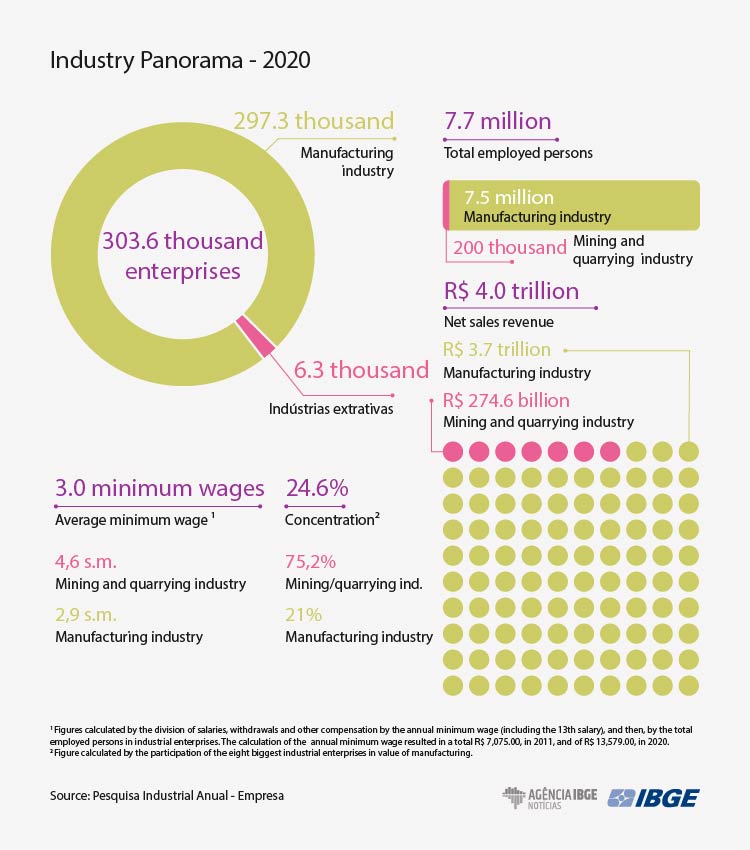Annual Survey of Industry
Industry loses 9.6 thousand enterprises and one million jobs in ten years
July 21, 2022 10h00 AM | Last Updated: July 22, 2022 02h00 AM
Highlights
- From 2011 to 2020, industry lost 9,579 enterprises, or 3.1% of the total, besides 1.0 million jobs (-11.6% of the total), with 5,747 vacancies in mining and quarrying industry and 998,.200 in manufacturing industry.
- Between 2019 and 2020, industry lost 2,865 enterprises (-0.9%), but the employed population increased¨by 0.5%, ou 35,241 employed persons.
- The net revenue of industry hit R$ 4.0 trillion in 2020, with 93.1% of the revenue concentrated in manufacturing industry.
- Among the activities, food industry leads with 24.1% of participation and an increase of 5.9 percentage points (p.p.) in 10 years, of which 3.6 p.p. were between 2019 and 2020.
- Car industry lost 4.9 p.p in 10 years, with a decrease from 12.0% to 7.1% in the period. The participation of Manufacture of chemicals increased from 8.8% to 10.5%, and the item went from the fourth to the second position.
- Mining and quarrying industry accounted for 6.9% of the industry revenue in 2020, being a highlight the Extraction of metallic minerals (4.7%) and Extraction of petroleum and natural gas (1.4%).

In 2020, Brazil had 303.6 thousand enterprises with one or more employed persons, being 6.3 thousand in the mining and quarrying segment and 297.3 thousand in the manufacturing one. These enterprises generated R$ 4.0 trillion in net sales revenue (R$ 274.6 billion from mining and quarrying industry and R$ 3.7 trillion from manufacturing industry) and paid R$ 308.4 billion in salaries, withdrawals and other compensation.
These data come from the Annual Survey of Industry (PIA) - Enterprise, which encompasses mining and quarrying and manufacturing industries.

Since 2011, the number of industrial enterprises recorded the second consecutive decrease with the loss of 2,865 thousand enterprises (-0.9%) from 2019. Since 2013, peak of the 10-year time series, there was a drop of 9.4% (31.4 thousand enterprises).
In 2020, the industrial sector employed 7.7 million persons and 97.4%of them were in manufacturing industry. Industry lost 1.0 million job posts between 2011 and 2020. From 2013, peak of the ten-year period analyzed, there was a decrease of 15.3% in vacancies.

“There has been a trend to decrease in the number of companies since 2014, start of the crisis. Between 2019 and 2020, there was a decrease of 0.9% in the number of enterprises, with 0.8% in mining and quarrying industries and 0.9% in manufacturing industry. The number of local branches fell by 1.2% from 2019, being 1.3% in the case of mining and quarrying industry and 1.1% of manufacturing industry,” says Synthia Santana, IBGE’s manager of Structural Analysis.

Nine of the 29 subsectors of industry have lost employees since 2011
Between 2011 and 2020, more than half of the losses of job posts was observed in the sectors of Manufacture of wearing apparel (258.4 mil), Preparation of rawhides and manufacture of leather, travel articles and footwear (138.1 mil) and Manuafacture of metal products, except machinery and equipment (134.2 thousand).
The biggest increases were regisstered by the food industry, main employer in the sector, followed by manufacture of non-metallic products and rubber and plastic products. Because new job posts are more common in sectors with lower earnings, the average salary of indudsty fell in 2020.
In ten years, the average salary paid by industryfell from 3.5 to 3.0 minimum wages. In spite of its higher salaries, mining and quarrying industry reduced its average salary, with a change from 6.1 minimum wages in 2011 to 4.6 minimum wages in 2020. In manufacturing industry, the average salary fell from 3.5 minimum wages in 2011 to 2.9 minimum wages in 2020.
Against 2019, the average salary fell fromm3.2 to 3.0 minimum wages: in the case of mining and quarrying industry it remained at 4.6 minimum wages and of manufacturing industr, it fell from 3.1 to 2.9 minimum wages.
Average size of companies declines, but concentration increases
The average size of companies fell from 28 to 25 employed persons. Mining and quarrying ones kept the average of 32 persons per enterprise in 2011 and in 2020. In manufacturing industry, this average fell from 28 to 25 persons in the period.
In 2020, the eight biggest industrial enterprises accounted for 24.6% of the national Value of Manufacturing (VTI). In ten years, there was an increase in industrial concentration in the eight biggest enterprises of Mining and quarrying industry (+0.6p.p.) and manufacturing industry (+0.8p.p.). Between 2019 and 2020, concentration increased in mining and quarrying industry (1.5p.p.) and fell in manufacturing industry (-2.0 p.p.).
From 2011 to 2020, the participation of mining and quarrying industry in VTI went from 13.6% to 16.3%; whereas manufacturing industry fell from 86.4% to 83.7%.
Manufacture of vehicles loses 4.9 percentage points in participation
Between 2011 and 2020, there was a decrease in participation of industrial revenue, which amounted to 4.3 of the 4.8 trillion of the gross revenue. A total of R$ 457.0 billion referred to sales revenue, rendering of non-industrial services and other production activities (agriculture, livestock, sale of electricity, etc.) and the remaining, 12.2% of the total,resulted from other types of financial, operational and non-operational revenues.
The participation of manufacture of motor vehicles, trailers and bodies in net revenue of industry (7.1%) fell 4.9 p.p., and wen from the 2nd to the 4th position in the ranking, in 2020. On the other hand, Manufacture of chemicals went from the fourth to the second position in 10 years, having jumped from 8.8% to 10.5% of the turnover.
“The performance of the car sector is related to the fact that others have increased at a higher rate, besides the very decrease of the sector itself. The activity has faced repeated crises caused by different reasons since 2009. In 2011, participation was of 12%, but it dropped, mainly in the period 2015-2016, when it reached 8.2 and 8.1%, till it reached the lowest result of the series, 7.1% in 2020,”says Synthia Santana.
Southeast reduces participation, but it still holds more than 50% of the revenue
In spite of the biggest decrease in participation in ten years (-4.6p.p.), the Southeast still concentrates 56.3% of the national VTI in 2020. The North Region was the one that recorded the biggest increase in participation (2.5 p.p.), followed by the Central West (1.7 p.p.).
Industry in São Paulo, which led national production with 30.4% of the total in 2020, recorded the biggest drop (-2.5 p.p.) between 2019 and 2020. The advance of industry in Minas - second most important in the country (12.5% in 2020), with 1.0 p.p., made up for that result to some extent.
“The advance in participation of the North and Central West Region may have been affected by mining and quarrying industry and agriculture industry, which were less jeopardized by the sanitary crisis,” the manager adds.



















